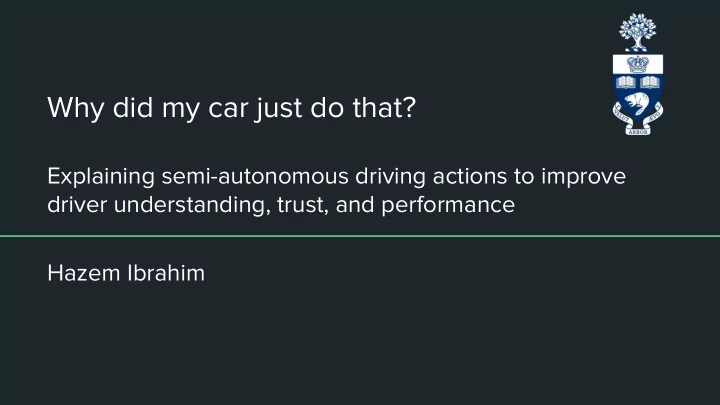

Why did my car just do that? Explaining semi-autonomous driving actions to improve driver understanding, trust, and performance Hazem Ibrahim
Agenda 1. Background and Introduction 2. Methodology 3. Results 4. Discussion 5. Future Work
Authors ● Jeamin Koo - PhD Candidate at Department of Mechanical Engineering, Stanford University Wendy Ju - Assistant Professor at the Information Science Department, Cornell ● Tech ● Jungsuk Kwac - Department of Electrical Engineering, Stanford University.
Background “Designers are challenged to model appropriate ways of conveying necessary and timely information to the driver” “We must design our technologies for the way people actually behave, not the way we would like them to behave” - Don Norman
Feedforward vs Feedback ● The central problems in conveying information are inadequate action and inappropriate feedback. Feedback alone is not sufficient, you need ● context! ● Authors argue that in ADS scenarios, feedback is not sufficient. Feedforward information is required to provide information ahead of an event.
Research Question “When it comes to informing drivers about impending autonomous behaviour, how should we generate appropriate messages explaining the machine’s intelligence and intention?”
Messages How Why How + Why Information about how Situational information Combination of both the car is acting. explaining the how and why messages reasoning for engaging “Car is braking.” “Car is braking due to automation. obstacle ahead” “Obstacle Ahead”
Methodology 1. Participants a. 64 university aged participants (32 male and 32 female). b. All had between two and ten years of driving experience. 2. Apparatus a. STISIM driving simulator equipped with auto-braking functionality in the case of an impending collision. b. 12-km driving course incorporating urban, suburban and highway sections with changing driving conditions. 3. Procedure a. 5 min practice course b. 30 min test course c. Online Questionnaire to assess driving experience and their reactions to the warning system
Dependent Variables Attitudinal Measures Behavioural Measures 1. Emotional Valence Safe driving analyzed by data collected from the simulator with regards to: a. How well do the following words collisions, speeding, traffic light describe how well you felt while driving? violations, stop signs missed, road edge 2. Machine Acceptance excursions, and driving time. a. How well do the following adjectives describe the car?
Emotional Valence 1. Least positive emotional valence when a combination of both how and why was given to the user. 2. Most positive when only the why message was included.
Machine Acceptance 1. Why message had significant effect on driver acceptance of the automated system.
Safe Driving Behaviour 1. When users did not receive the how message, why message made no difference. 2. If user was told the how without the why, they “drove” significantly worse. 3. Safest driving performance when both how and why were delivered.
Discussion ● Why did users respond negatively to the how + why message? Cognitive Load? ○ ○ “...the consumer appeal of the product does not always correlate with high performance and satisfaction in actual use.” ● Why did the how message on its own not do well? ○ Locus of control (Driver/Internal vs System/External) ○ Endsley’s model of Situational Awareness ○ Was the car being impolite? Why did users like the why message? ● ○ Gave enough information without being redundant.
Future work ● Towards Cooperative Driving: Involving the Driver in an Autonomous Vehicle's Decision Making ○ Marcel Walch, Tobias Seiber, Philip Hock (Institute of Media Informatics, Ulm University, Germany)
My concerns with the paper 1. Are driving simulators sufficient in mimicking real driving conditions? 2. Is the participant group diverse enough to capture user behaviour? 3. The authors’ notion of safe driving behaviour was too basic. 4. How can we guarantee enough time for feedforward information to be delivered before automated action is taken? 5. Is a voice alert the best way to convey information to the user?
Thank you for listening. Questions?
Recommend
More recommend